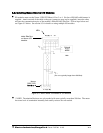
Electro Industries/GaugeTech
Doc # E107706 V1.25 8-2
8.3:
TOU
Prior
Season
and
Month
Q
The Nexus 1250/1252 Monitor stores accumulations for the prior season and the prior month. When
the end of a billing period is reached, the current season or month becomes stored as the prior. The
registers are then cleared and accumulations resume, using the next set of TOU schedules and
register assignments from the stored calendar.
Q
Prior and current accumulations to date are always available.
8.4:
Updating,
Retrieving
and
Replacing
TOU
Calendars
Q
Communicator EXT software retrieves TOU calendars from the Nexus 1250/1252 Monitor or from
the computer’s hard drive for review and edit.
Q
Up to a maximum of twenty yearly calendars can be stored in the Nexus 1250/1252 Monitor at any
given time. You may retrieve them one at a time; a new calendar can be stored while a current
calendar is in use.
Q
Accumulations do not stop during calendar updates. If a calendar is replaced while in use, the
accumulations for the current period will continue until the set end date. At that point, the current
time will become the new start time and the settings of the new calendar will be used.
Q
Reset the current accumulations, if you replace a calendar in use. A reset clears only the current
accumulation registers. This causes the current accumulations to use the present date as the start and
accumulate to the next new end date, which will be taken from the new calendar. Once stored, prior
accumulations are always available and can not be reset. See the Nexus Communicator User Manual
for how to reset TOU accumulations.
Q
At the end of a defined period, current accumulations are stored, the registers are cleared and
accumulations for the next period begin. When the year boundary is crossed, the second calendar, if
present, is used. To retain continuity, you have up to one year to replace the old calendar with one
for the following year.
8.5:
Daylight
Savings
and
Demand
Q
To use Daylight Savings Time, you must enable it in the Nexus Monitor’s Device Profile, Time
Settings. Click Auto DST, which sets Daylight Savings Time automatically (for the United States
ONLY). You can also select User Defined and enter the desired dates for Daylight Savings Time.
See the Communicator EXT User Manual for details.
Q
To set Demand Intervals, from the Device Profile select Demand Integration and set the desired
intervals.
To set Cumulative Demand Type, from the Device Profile click Cold Load Pickup and select
Block or Rolling Window Average.


















